- EXPLORE Random Article
- Happiness Hub

How to Conclude a Speech
Last Updated: May 15, 2023 Approved
This article was co-authored by Gale McCreary . Gale McCreary is the Founder and Chief Coordinator of SpeechStory, a nonprofit organization focused on improving communication skills in youth. She was previously a Silicon Valley CEO and President of a Toastmasters International chapter. She has been recognized as Santa Barbara Entrepreneurial Woman of the Year and received Congressional recognition for providing a Family-Friendly work environment. She has a BS in Biology from Stanford University. wikiHow marks an article as reader-approved once it receives enough positive feedback. In this case, several readers have written to tell us that this article was helpful to them, earning it our reader-approved status. This article has been viewed 117,527 times.
The last moments are where a good speech can be made. If you want to leave your audience stunned, you can learn the basics needs of a good conclusion, as well as some tactics for ending creatively. You can also learn what techniques to avoid.
Things You Should Know
- Summarize the main points of your speech to remind listeners what they've learned.
- Recall something from the introduction so your speech comes full circle.
- Thank your audience for attending and listening.
Concluding Your Speech

- Use the chance to repeat your thesis a final time, if necessary. What's the one thing you hope someone remembers from your speech? What's the one thing that needs to be learned?
- In informal speeches, repeating the main points won't be necessary. If you're giving a toast at a wedding, you don't need to run back through a list of the great things about the groom.

- If you started the speech by drawing a sad portrait of a recently returned veteran who couldn't get work, or health insurance, and ended up in dire straits, that can be a heart-breaking intro. Pick back up with the story in conclusion to let you know where that vet is now.
- Any kind of reference can work. If you started a speech with a quote by Thomas Paine, end with more about Thomas Paine. The bookend technique is an excellent way of signaling the end for the audience.

- Put a face on things. Case studies and personal examples are extremely effective in helping an audience connect with a complicated issue or topic.
- Some people like to use this technique for the introduction, but it can be unexpected and even more effective to wait and use it at the conclusion, especially for speeches that are a little bit shorter.

- "We can turn back the oceans and stop the warming of our planet. It's not too late, as the title of my speech promises. It's not too late for any of us."

- It's also appropriate to use a "thank you" as the very last thing that you say: "We must continue fighting the good fight on climate change, for our children, for our economy, and for ourselves. Thank you." Cue applause.
- Sometimes, it's also appropriate to ask for questions if the occasion calls for it. People should be sure your speech is over, but if people seem hesitant, it's ok to say, "I'd be happy to take questions, if anyone has them."
Nailing the Ending

- "The fight for climate change (pause ) is a fight (pause) that we must (pause) win. Our children (pause). Our children's children (pause). Demand it."

- Return to the story of the veteran struggling to find work. With the sorts of infrastructure you're calling for in your speech, maybe he could be working a specific job, and getting into his own house, and even starting to plant a garden in the yard, something he always wanted to do. Dream a little, and let your audience do the same.

- "We must do this for our children, we must do this for our neighbors, we must do this for America, we must do this for the world, we must do this for the oceans, we must do this for the forests..."
- "Politicians can't legislate this. Architects can't build this. Artists can't dream this. Developers can't innovate this. Only you can do this."

- Address the audience specifically. Start using "you" toward the end of the speech, or address an individual in the audience to help bring it home.
Avoiding Common Mistakes

- "Well, that's pretty much it."
- "That's it."
- "I'm done."

- When the speech is over, don't keep talking. Even if you just remembered a point you forgot to make a few minutes ago, don't launch back into the speech when people are clapping, or once they're finished. When the speech is over, let it be over. If there's a chance for Q & A, then get to it then.

- Some speeches can be leavened with a bit of humor in the ending. If you've just given a particularly touching toast at a wedding, it might be good to release a bit of the tension with a well-placed gag. Probably not so much for a professional presentation.
Community Q&A
- Don't overwrite it. After your first few drafts, sit back and let it rest a few days. Then come back to your ending with new perspective. Pretend that you are listening to someone else say it for the first time. Read it like you will at the event. Then go back to editing. Thanks Helpful 4 Not Helpful 0
- Catch your audience's attention. Use a shocking fact, or statistic that will leave the listeners thinking and will urge them to action. Thanks Helpful 2 Not Helpful 0
You Might Also Like

- ↑ https://www.hamilton.edu/academics/centers/oralcommunication/guides/introductions-and-conclusions
- ↑ https://westsidetoastmasters.com/article_reference/12_ways_to_end_your_speech.html
- ↑ https://www.indeed.com/career-advice/career-development/how-to-conclude-a-presentation
- ↑ https://courses.lumenlearning.com/boundless-communications/chapter/conclusion/
- ↑ https://www.linkedin.com/pulse/best-call-action-speech-examples-mitch-carson?trk=public_profile_article_view
- ↑ https://www.hamilton.edu/academics/centers/oralcommunication/guides/avoid-these-common-speech-mistakes-1
About this article

To conclude a speech, try summarizing the main points you made throughout it so you can remind the listener what you want them to learn or take away. In some cases, you can use the conclusion to recall the introduction, showing how the speech comes full circle. Or, if you have a catchy title, work it into the conclusion to grab your audience's attention. You can also signal the ending by thanking the audience for listening or simply stating “In conclusion” to let your listeners know it’s time to wrap up. To put extra emphasis on your ending, slow your speech to get people to perk up and really hear your final points. To learn how to use your conclusion as a call to action, keep reading! Did this summary help you? Yes No
Reader Success Stories
Gaukhu Bankar
Aug 14, 2019
Did this article help you?

Oct 18, 2017
Yasar Arfath
Aug 23, 2018
Nov 26, 2017
Sep 18, 2016

- About wikiHow
- Terms of Use
- Privacy Policy
- Do Not Sell or Share My Info
- Not Selling Info
My Speech Class
Public Speaking Tips & Speech Topics
Writing the Conclusion of a Speech

Jim Peterson has over 20 years experience on speech writing. He wrote over 300 free speech topic ideas and how-to guides for any kind of public speaking and speech writing assignments at My Speech Class.

One of the best ways to conclude a speech is to tie the conclusion into the introduction. For example, you might begin your speech by telling a suspenseful story that relates to your topic, but save the end of the story for the very end of your speech. Or refer back to the same quotation. Or refer to the joke that you told. Any of these strategies will give your speech a sense of connection and closure, and will leave the audience with a great final impression.
If you are delivering a persuasive speech, you might try a slightly different ending because your goal is not just to be remembered, it’s to inspire people to take action. One way to do this is to issue a call-to-action. This means that you specifically tell your audience what actions you expect them to take related to your speech. Another way to inspire action with the conclusion of your speech is to appeal to their emotions. If you create a desired emotion within your audience, and then leave them with that emotion, they will take that emotion with them. For example: If you leave them feeling guilty about not-recycling by painting a bleak picture about the state of the Earth that their grandchildren will live in, then they might recall that emotion the next time they choose not to recycle and alter their behavior.
Leaving a strong final impression is the most important aspect of the conclusion, but their are some other necessary steps as well:
- Making a smooth transition from the body of the speech to the conclusion is crucial. To do this, use a signpost known as a concluding statement. The most common concluding statements include: “in conclusion”, “I leave you with”, “finally today”, and other similarly obvious endings.
- Just as it is important to preview a speech in the introduction, it is important to summarize the speech in the conclusion. The more the audience hears your main points, the more likely they are to remember them. By previewing, discussing, and summarizing your main points your audience will be exposed to them at least three times during your speech.
A good conclusion should be about 5-10% of the total speech length. Anything shorter that 5% means that the ending has come too abruptly. Anything more that 10%, and the audience may become restless. This brings up another point: If it sounds like a conclusion, you need to finish your speech in a reasonable amount of time. The conclusion is not the place to add new material.
Effective ways to end a speech
- Summarize the main speech topics or main points.
- Repeat a few keywords or phrases by using the rhetorical figure of speech repetition.
- State how your points prove your general and specific goal.
- Restate and reinforce the central idea.
- Repeat the tie between the needs and interests of the listeners, and your thesis.
- Refer back to an anecdote or quotation in the introduction text.
- Offer a so-called moral of the story.
- Call them to act and offer them how-to-do-it steps.
- List the benefits or available applications; very effective ways to end a speech.
- Restate the problem and provide your solution in two sentences.
- Visualize the outcome of your call to action with a prop or visual aid.
- Transform your central idea or even the discourse title into an easy to remember slogan.
- Recite a couple of lines from songs, poems or citations and quotes from a historical presentation.
- End with a heart-felt human interest story in which all comes together.
- Finish with a clinching personal anecdote.
- Close with an illustrative design example.
- End with a joke or funny remark. Must say that only choose these ways to end a speech if it’s really funny.
- Connect your speech topics with the common grounds and thoughts of the public speaking audience. This way to end a speech brings the overall speech topic in their hearts and minds.
- Ask a rhetorical question and answer with an easy to remember oneliner.
- Give the ultimate answer on an important question you proposed earlier in your introduction.
- Surprise with a shocking fact or figure that empahizes the need for change.
- Draw the contours of the ideal situation you propose. Visualize that they will see paradise if they do, think or act as you want.
Speech Anxiety
Writing a Speech
2 thoughts on “Writing the Conclusion of a Speech”
Great information,but need samples to further help us understand
I want to have and example of conclusion please
Leave a Comment
I accept the Privacy Policy
Reach out to us for sponsorship opportunities
Vivamus integer non suscipit taciti mus etiam at primis tempor sagittis euismod libero facilisi.
© 2024 My Speech Class

Closing Remarks for Speech
Ai generator.
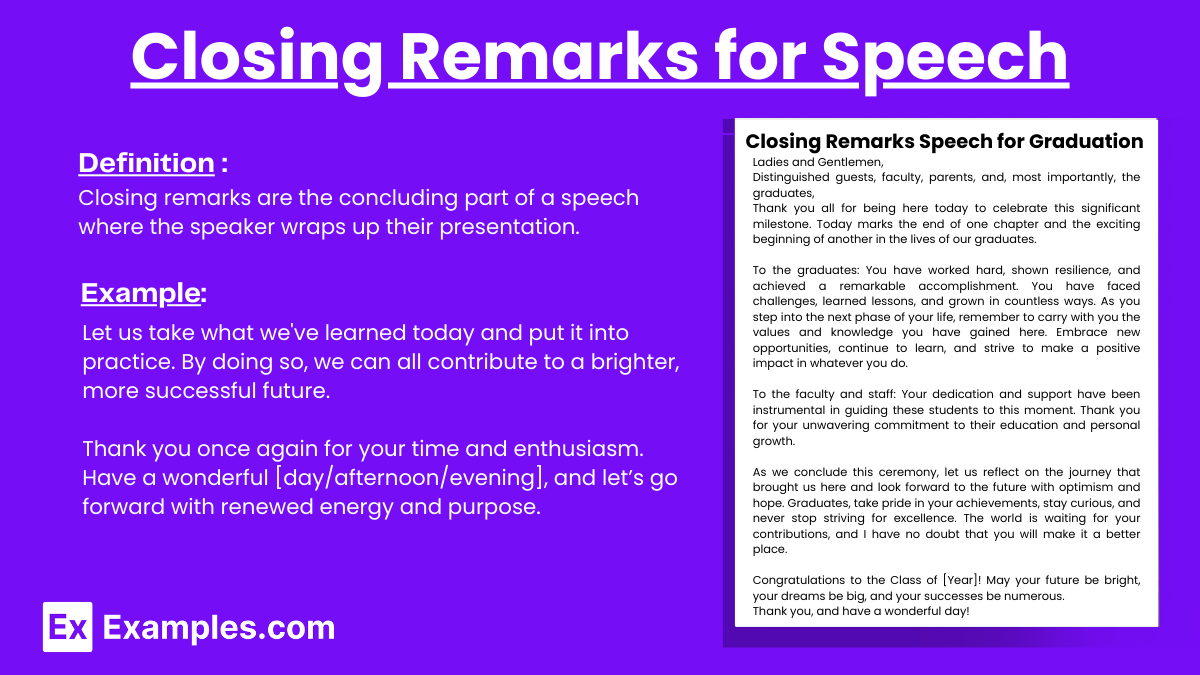
Closing remarks are the concluding part of a Speech where the speaker wraps up their presentation. This section typically summarizes the key points discussed, reinforces the main message, and leaves the audience with a final thought or call to action. Closing remarks are important as they provide a sense of closure and can have a lasting impact on the audience.
What is Closing Remarks for Speech?
Closing remarks are the final statements in a speech, where the speaker brings everything to a conclusion. This part of the speech is designed to recap the main points, emphasize the central message, and offer a final takeaway for the audience. It ensures that the speech ends on a strong note, leaving a lasting impression on the listeners.
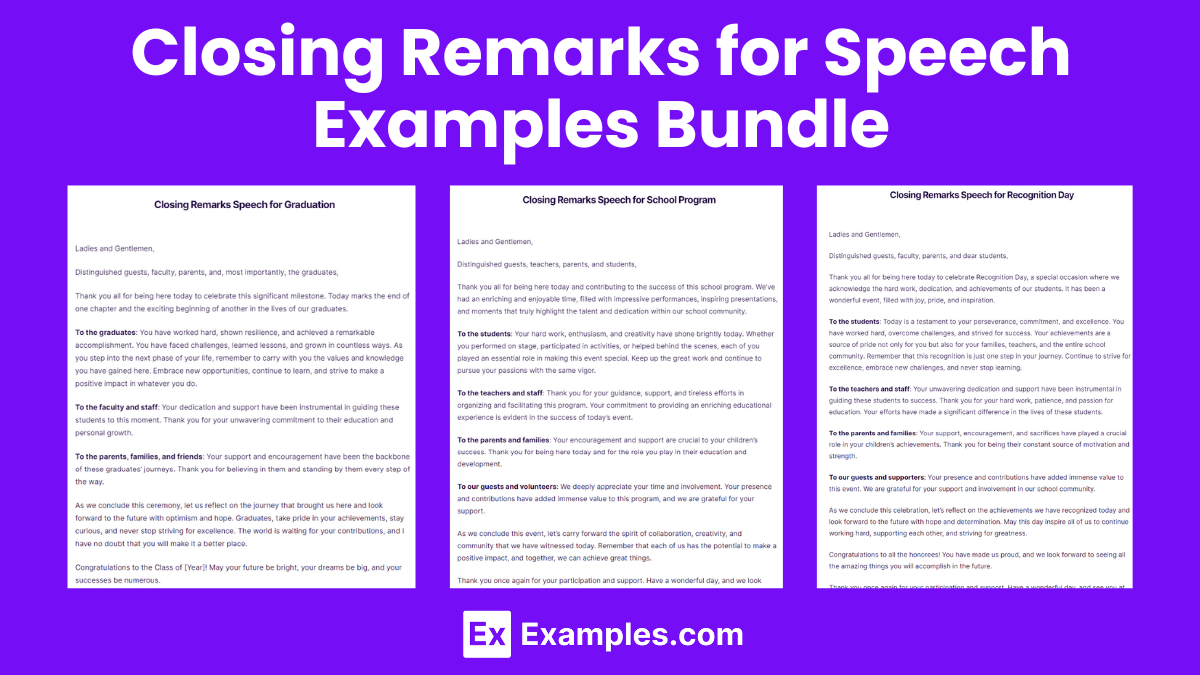
Closing Remarks for Speech Bundle Download
Closing Remarks for Speech Format
1. summarize key points.
Briefly recap the main ideas or arguments presented in your speech. Example : “Today, we discussed the importance of time management, practical strategies to implement it, and the benefits it brings.”
2. Reinforce the Main Message
Emphasize the core message or takeaway you want the audience to remember. Example: “Remember, effective time management is crucial for reducing stress, increasing productivity, and achieving your goals.”
3. Call to Action
Encourage the audience to take specific actions or steps based on your speech. Example: “I encourage each of you to start using a planner, set specific goals, and tackle your most important tasks first.”

4. Thank the Audience
Express gratitude for their time and attention. Example: “Thank you all for your attention and engagement today.”
5. End with a Memorable Closing
Finish with a powerful quote, a thought-provoking statement, or an inspiring note. Example: “As the saying goes, ‘The bad news is time flies. The good news is you’re the pilot.’ Make the most of your time and steer your life towards success.”
Closing Remarks for Speech Example
Today, we’ve explored the importance of effective time management, discussed practical strategies to implement it, and highlighted the numerous benefits it brings. Remember, managing your time well is crucial for reducing stress, increasing productivity, and achieving your goals. I encourage each of you to start using a planner, set specific goals, and tackle your most important tasks first. By doing so, you will take control of your time and pave the way for a more balanced and successful life. Thank you all for your attention and engagement today. As the saying goes, “The bad news is time flies. The good news is you’re the pilot.” Make the most of your time and steer your life towards success. Thank you!
Short Closing Remarks for Speech Example
Today, we explored the importance of effective time management and practical strategies to achieve it. Remember, managing your time well reduces stress, increases productivity, and helps you reach your goals. I encourage you to start using a planner, set specific goals, and tackle your most important tasks first. Thank you for your attention. As the saying goes, “The bad news is time flies. The good news is you’re the pilot.” Make the most of your time and steer your life towards success. Thank you!
Closing Remarks for Speech for Graduation
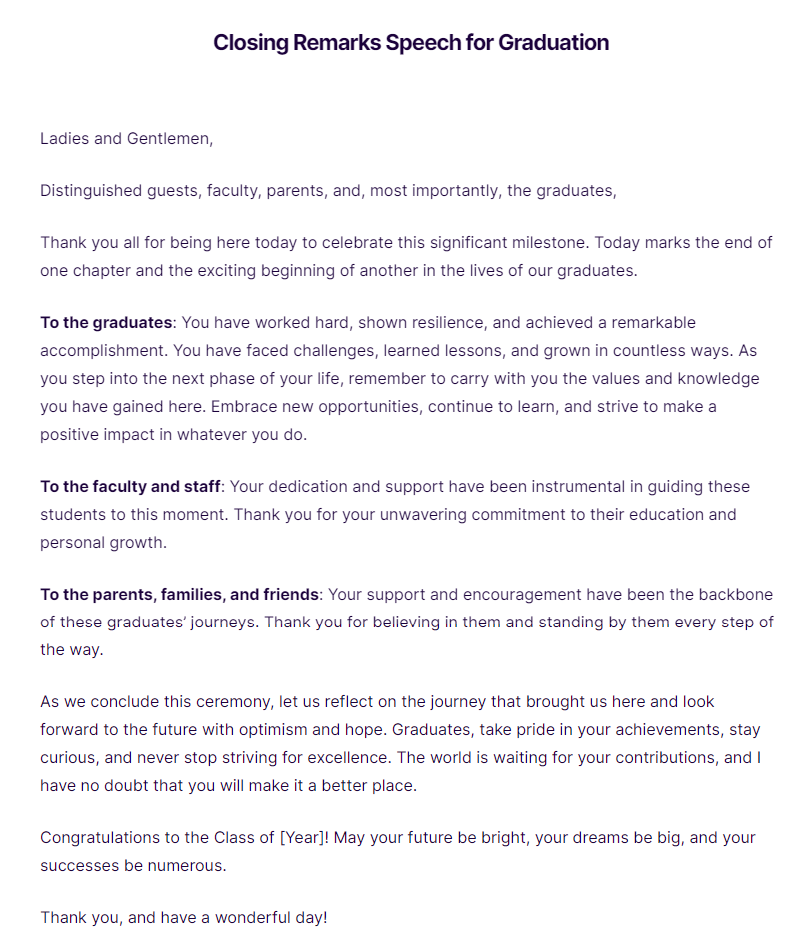
Closing Remarks for Speech for School Program
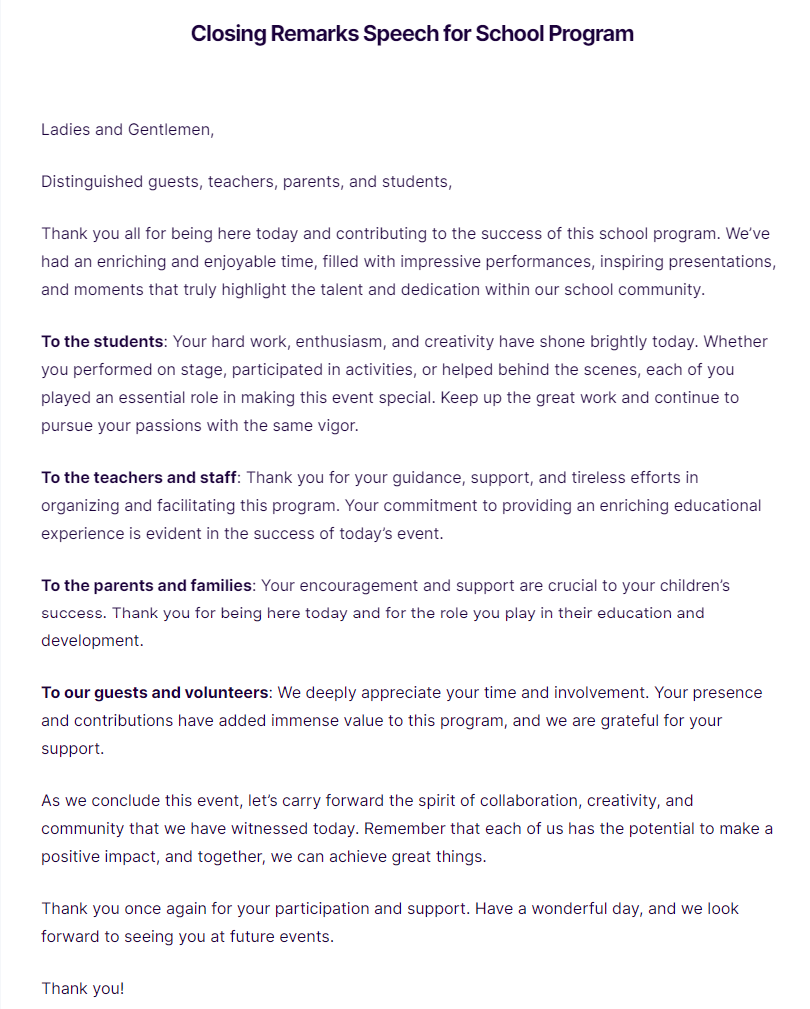
Closing Remarks for Speech for Recognition Day
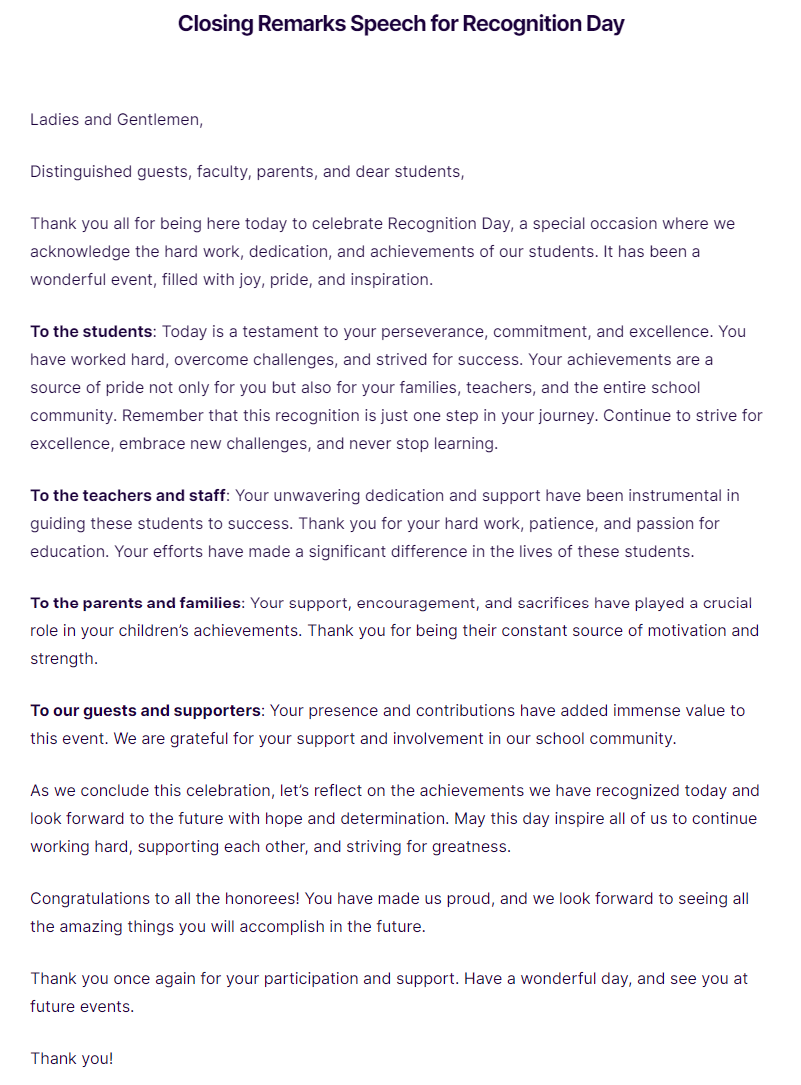
More Closing Remarks for Speech Topics
- Closing Remarks Speech for an Event
- Closing Remarks Speech for Seminar
- Closing Remarks Speech for Teachers Day
- Closing Remarks Speech for Christmas Party
- Closing Remarks Speech for Valedictorian
- Closing Remarks for Speech Contest
- Closing Remarks Speech for Wedding
- Closing Remarks Speech for Conference
- Closing Remarks Speech for Award Ceremony
- Closing Remarks Speech for Farewell
- Closing Remarks Speech for Workshop
- Closing Remarks Speech for Business Meeting
- Closing Remarks Speech for Retirement
- Closing Remarks Speech for Fundraiser
- Closing Remarks Speech for Community Event
- Closing Remarks Speech for Gala
- Closing Remarks Speech for Annual General Meeting
- Closing Remarks Speech for Orientation
- Closing Remarks Speech for Leadership Summit
- Closing Remarks Speech for Charity Event
- Closing Remarks Speech for Memorial Service
- Closing Remarks Speech for Family Reunion
- Closing Remarks Speech for Corporate Event
- Closing Remarks Speech for Product Launch
- Closing Remarks Speech for Training Session
- Closing Remarks Speech for Cultural Festival
- Closing Remarks Speech for Political Rally
How to Write Closing Remarks for Speech
Briefly recap the main ideas or arguments presented.
Example: “Today, we discussed the importance of time management, practical strategies to implement it, and the benefits it brings.”
Emphasize the core message or takeaway you want the audience to remember.
Example: “Remember, effective time management is crucial for reducing stress and achieving your goals.”
Encourage the audience to take specific actions based on your speech.
Example: “I encourage you to start using a planner and prioritize your tasks.”
Express gratitude for their time and attention.
Example: “Thank you all for your attention.”
Finish with a powerful quote, a thought-provoking statement, or an inspiring note.
Example: “As the saying goes, ‘The bad news is time flies. The good news is you’re the pilot.’ Make the most of your time.”
Tips to Deliver Closing Remarks for Speech
1. Summarize Key Points : Briefly recap the main ideas discussed in your speech.
2. Reinforce the Main Message : Emphasize the core message you want the audience to remember.
3. Call to Action : Encourage the audience to take specific steps or actions based on your speech.
4. Express Gratitude : Thank the audience for their time and attention.
5. End with a Memorable Closing : Finish with a powerful quote, thought-provoking statement, or inspiring note.
Why are closing remarks important?
They reinforce the message, ensure audience retention, and provide a clear, memorable conclusion.
How should I structure closing remarks?
Summarize key points, thank the audience, and end with a powerful, memorable statement or call to action.
Can I include a quote in my closing remarks?
Yes, a relevant and impactful quote can effectively reinforce your message and leave a lasting impression.
What should I avoid in closing remarks?
Avoid introducing new information, being too lengthy, or ending abruptly without a clear conclusion.
How do I make my closing remarks engaging?
Use a strong, positive tone, include a personal touch or story, and connect emotionally with the audience.
Can humor be part of closing remarks?
Yes, appropriate humor can leave a positive impression and end your speech on a high note.
How long should closing remarks be?
Closing remarks should be concise, typically lasting no more than a few minutes.
What is a call to action in closing remarks?
A call to action urges the audience to take specific steps or actions related to your speech’s message.
Should I thank the audience in my closing remarks?
Yes, thanking the audience shows appreciation and fosters a positive connection.
Can I use a rhetorical question in my closing remarks?
Yes, a rhetorical question can provoke thought and leave the audience reflecting on your message.
Text prompt
- Instructive
- Professional
10 Examples of Public speaking
20 Examples of Gas lighting

IMAGES
VIDEO